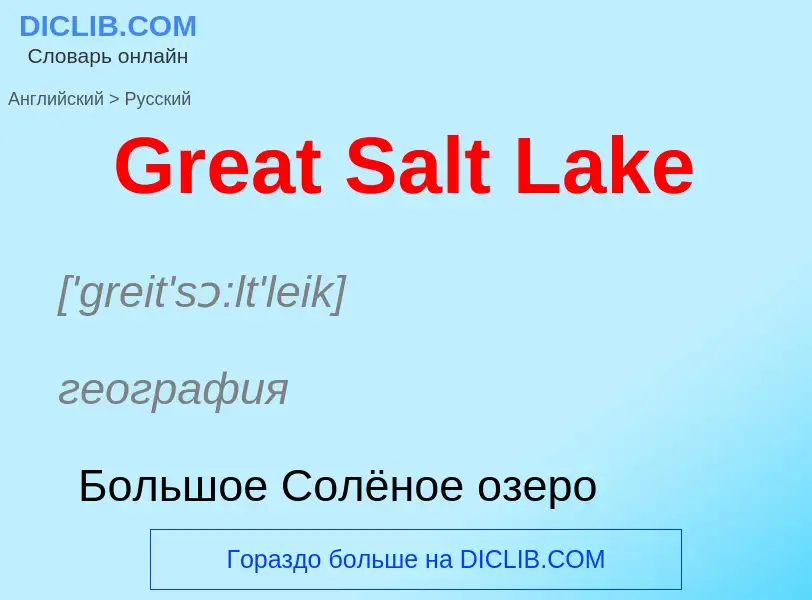Translation and analysis of words by ChatGPT artificial intelligence
On this page you can get a detailed analysis of a word or phrase, produced by the best artificial intelligence technology to date:
- how the word is used
- frequency of use
- it is used more often in oral or written speech
- word translation options
- usage examples (several phrases with translation)
- etymology
Great Salt Lake - translation to russian
['greit'sɔ:lt'leik]
география
Большое Солёное озеро
['sɔ:lt'leik'siti]
география
г. Солт-Лейк-Сити
существительное
общая лексика
г. Солт-Лейк-Сити
Definition
Wikipedia

The Great Salt Lake (Shoshone: Ti'tsa-pa “Bad Water”) is the largest saltwater lake in the Western Hemisphere and the eighth-largest terminal lake in the world. It lies in the northern part of the U.S. state of Utah and has a substantial impact upon the local climate, particularly through lake-effect snow. It is a remnant of Lake Bonneville, a prehistoric body of water that covered much of western Utah.
The area of the lake can fluctuate substantially due to its low average depth of 16 feet (4.9 m). In the 1980s, it reached a historic high of 3,300 square miles (8,500 km2), and the West Desert Pumping Project was established to mitigate flooding by pumping water from the lake into the nearby desert. In 2021, after years of sustained drought and increased water diversion upstream of the lake, it fell to its lowest recorded area at 950 square miles (2,500 km2), falling below the previous low set in 1963. Continued shrinkage could turn the lake into a bowl of toxic dust, poisoning the air around Salt Lake City.
The lake's three major tributaries, the Jordan, Weber, and Bear rivers together deposit around 1.1 million tons of minerals in the lake per year. Since the lake has no outlet besides evaporation, these minerals accumulate and give the lake high salinity (far saltier than seawater) and density. This density causes swimming in the lake to feel similar to floating.
The lake has been called "America's Dead Sea" and provides a habitat for millions of native birds, brine shrimp, shorebirds, and waterfowl, including the largest staging population of Wilson's phalarope in the world.


![Stansbury]]'s 1852 map of the Great Salt Lake and adjacent country in the [[Utah Territory]] Stansbury]]'s 1852 map of the Great Salt Lake and adjacent country in the [[Utah Territory]]](https://commons.wikimedia.org/wiki/Special:FilePath/1852 Stansbury Map of Utah and the Great Salt Lake - Geographicus - GreatSaltLake-stansbury-1852.jpg?width=200)

![American avocets at [[Bear River Migratory Bird Refuge]] American avocets at [[Bear River Migratory Bird Refuge]]](https://commons.wikimedia.org/wiki/Special:FilePath/American Avocet 2.jpg?width=200)
.jpg?width=200)
![Great Salt Lake from airspace over [[Salt Lake City]] Great Salt Lake from airspace over [[Salt Lake City]]](https://commons.wikimedia.org/wiki/Special:FilePath/Great Salt Lake 2.jpg?width=200)



 (cropped).jpg?width=200)
 - Geographicus - SaltLakeCity-harpersweekly-1866.jpg?width=200)
![The [[Olympic flame]] burns at [[Rice-Eccles Stadium]]. Salt Lake City hosted the 2002 Winter Olympics. The [[Olympic flame]] burns at [[Rice-Eccles Stadium]]. Salt Lake City hosted the 2002 Winter Olympics.](https://commons.wikimedia.org/wiki/Special:FilePath/2002 Winter Olympics flame.jpg?width=200)
![Salt Lake City c. 1880 by [[Carleton E. Watkins]] Salt Lake City c. 1880 by [[Carleton E. Watkins]]](https://commons.wikimedia.org/wiki/Special:FilePath/55. Salt Lake City Utah.jpg?width=200)
![Wasatch Mountains]] is a major source of employment. Wasatch Mountains]] is a major source of employment.](https://commons.wikimedia.org/wiki/Special:FilePath/Alta Albion Basin Entrance.jpg?width=200)

![UTA [[transit bus]]es at the [[Salt Lake City Intermodal Hub]] (Salt Lake Central Station) UTA [[transit bus]]es at the [[Salt Lake City Intermodal Hub]] (Salt Lake Central Station)](https://commons.wikimedia.org/wiki/Special:FilePath/Buses at Central Station.jpg?width=200)


![Comic Con]] at Salt Palace Convention Center Comic Con]] at Salt Palace Convention Center](https://commons.wikimedia.org/wiki/Special:FilePath/Crowds in the Salt Palace Convention Center at the 2014 Salt Lake Comic Con in Salt Lake City, Utah.jpg?width=200)
![Denver and Rio Grande Western Depot]] now serves as home to the Utah Department of Heritage and Arts and the Rio Gallery. Denver and Rio Grande Western Depot]] now serves as home to the Utah Department of Heritage and Arts and the Rio Gallery.](https://commons.wikimedia.org/wiki/Special:FilePath/Denver & Rio Grande Western Depot in SLC - Feb 3, 2011.jpg?width=200)
![[[Vivint Arena]] has been the home of the [[Utah Jazz]] since 1991. [[Vivint Arena]] has been the home of the [[Utah Jazz]] since 1991.](https://commons.wikimedia.org/wiki/Special:FilePath/Energy solutions arena.jpg?width=200)

![North Temple Bridge/Guadalupe Station]] in Salt Lake City North Temple Bridge/Guadalupe Station]] in Salt Lake City](https://commons.wikimedia.org/wiki/Special:FilePath/Frontrunner north temple station.jpg?width=200)
![Gallivan Plaza Station]] Gallivan Plaza Station]]](https://commons.wikimedia.org/wiki/Special:FilePath/Green line Trax at Gallivan Plaza.jpg?width=200)


![Köppen climate types]] of Utah Köppen climate types]] of Utah](https://commons.wikimedia.org/wiki/Special:FilePath/Köppen Climate Types Utah.png?width=200)
![TRAX]] runs along Main through the heart of the city. TRAX]] runs along Main through the heart of the city.](https://commons.wikimedia.org/wiki/Special:FilePath/Main Street, Salt Lake City 2021.jpg?width=200)
![[[Plat]] of Salt Lake City, circa 1870s [[Plat]] of Salt Lake City, circa 1870s](https://commons.wikimedia.org/wiki/Special:FilePath/Platslc.jpg?width=200)
.png?width=200)

![Salt Lake International Airport sits between downtown Salt Lake City and the [[Great Salt Lake]]. Salt Lake International Airport sits between downtown Salt Lake City and the [[Great Salt Lake]].](https://commons.wikimedia.org/wiki/Special:FilePath/SLC airport, 2010.jpg?width=200)
![Hotel Newhouse]]. Hotel Newhouse]].](https://commons.wikimedia.org/wiki/Special:FilePath/Salt Lake City 1913 panorama.jpg?width=200)

![The Gateway]], where the Clark Planetarium is located. The Gateway]], where the Clark Planetarium is located.](https://commons.wikimedia.org/wiki/Special:FilePath/Salt Lake City 4892084585.jpg?width=200)
![Astronaut photography of Salt Lake International Airport in west SLC, taken from the [[International Space Station]] (ISS). North is at bottom. Astronaut photography of Salt Lake International Airport in west SLC, taken from the [[International Space Station]] (ISS). North is at bottom.](https://commons.wikimedia.org/wiki/Special:FilePath/Salt Lake City Utah.jpg?width=200)

![The [[Salt Palace]] Convention Center The [[Salt Palace]] Convention Center](https://commons.wikimedia.org/wiki/Special:FilePath/Salt Palace (43837757942).jpg?width=200)


![[[Zions Bancorporation]] headquarters in Salt Lake City [[Zions Bancorporation]] headquarters in Salt Lake City](https://commons.wikimedia.org/wiki/Special:FilePath/Slc gateway tower east.jpg?width=200)
![Wells Fargo Center]] building in Salt Lake City Wells Fargo Center]] building in Salt Lake City](https://commons.wikimedia.org/wiki/Special:FilePath/Slc kutv channel 2.jpg?width=200)
![[[Smith's Ballpark]], home of the [[Salt Lake Bees]] [[Smith's Ballpark]], home of the [[Salt Lake Bees]]](https://commons.wikimedia.org/wiki/Special:FilePath/Spring Mobile Park Apr09.jpg?width=200)


![Panorama of [[Temple Square]] taken in 1912 Panorama of [[Temple Square]] taken in 1912](https://commons.wikimedia.org/wiki/Special:FilePath/Temple Square 1912 panorama.jpg?width=200)
![KSL Radio]], and the [[Deseret News]] are located in the [[Triad Center]] in Salt Lake City. KSL Radio]], and the [[Deseret News]] are located in the [[Triad Center]] in Salt Lake City.](https://commons.wikimedia.org/wiki/Special:FilePath/Triad center slc utah.jpg?width=200)

